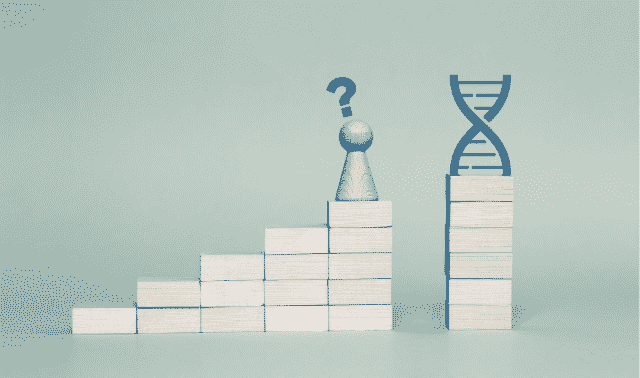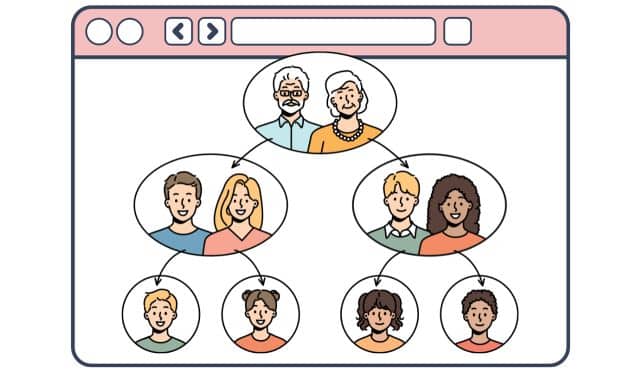Sign up for the Family Tree Newsletter! Plus, you’ll receive our 10 Essential Genealogy Research Forms PDF as a special thank you.
Get Your Free Genealogy Forms
"*" indicates required fields

You’ve had your DNA tested with a genetic genealogy company (maybe even more than one), you’ve reviewed your ethnicity estimate, and you’ve gone through your match list. Now what should you do? How do you maximize your testing dollars to wring every bit of useful genealogical information out of your DNA test(s)? The answer may be in tools at third-party websites or testing company blogs, which give you new ways to analyze your test results. That can lead you to revelations about your family tree.
Major DNA Testing Company Tools
Each of the major testing companies—23andMe, AncestryDNA, MyHeritage DNA and FamilyTreeDNA—offers tools its customers can use to interpret their results. But separate, third-party programmers and genetic genealogists have created DNA analysis tools and applications that are independent of the testing companies. They offer additional capabilities and features you won’t find provided by the testing companies, boosting what you’re able to accomplish genealogically with your DNA results.
Usually, you’ll register for a site, upload your raw DNA data (the numbers and letters assigned to your genomic variants and their positions on your chromosomes) and perform a variety of analyses. For example, the only way to compare raw DNA data from one company’s test to raw data from another company’s test is to have both sets of data uploaded to the same third-party tool.
ADVERTISEMENT
Third-Party DNA Tools
These tools can help you visualize your DNA in different ways, such as in detailed chromosome browsers that display which portions, or “segments,” of DNA you have in common with another user. You can produce spreadsheets that put the data at your fingertips and show you insightful patterns and trends in your DNA. They can help you use a complex research technique known as “triangulation,” in which you use data from two different sources—in this case, two of your matches’ genetic information—to draw conclusions about a third, unknown source (i.e., a shared mystery ancestor).
Other third-party tools let you expand your research company’s “in-common-with” (ICW) function, sometimes called shared matches. ICW tools outline which genetic relatives you and a DNA match both share, providing new research leads and collaboration opportunities.
Our guide will focus on the two most commonly utilized third-party tools, hosted by GEDmatch and DNAGedcom. Let’s dig into what each website can offer.
ADVERTISEMENT
GEDmatch
The most popular third-party tool is GEDmatch, created by Curtis Rogers and John Olson to help users can upload their raw DNA data and perform a variety of analyses. In October 2015, genetics news site GenomeWeb reported that GEDmatch “has over 130,000 registered users, over 200,000 samples in its DNA database, and more than 75 million individuals in its genealogical database.” The samples in the database are autosomal (at) DNA raw data results users have exported from 23andMe, AncestryDNA and FamilyTreeDNA, and uploaded to GEDmatch.
The first step to using GEDmatch is to register for a free account. The site offers additional tools for paying users, but the free account is sufficient to start with. Once you have a profile, you can access the GEDmatch tool and upload a “kit,” or the raw data results from a test, for processing and inclusion in the GEDMatch database. You’ll be assigned a number for each kit you upload; be sure to write this down where you won’t lose it.
Hover over the Free Tools tab on GEDmatch’s main page to see what’s available. Here are some of the most important and commonly tools:
“One-to-many” matches: These compare the raw data of a single kit to the raw data of every other kit in the GEDmatch database in order to identify genetic cousins who share an amount of DNA above the sharing threshold. The sharing threshold of 7 centimorgans (7 cMs), for example, means that two individuals must share a segment of DNA that is 7 cMs or longer in order to be identified as a genetic cousin using this tool.
One-to-one autosomal: This compares the atDNA data of a single kit to the atDNA data of one other kit to identify segments of atDNA shared between the kits above the sharing threshold. You can manually adjust the sharing threshold to be higher or lower than the default 7 cMs.
One-to-one X: This compares the X-chromosomal DNA (X-DNA) data of a single kit to the X-DNA data of one other kit in order to identify segments of X-DNA shared between the kits above the sharing threshold. Again, the default is 7 cMs, which you can adjust. X-DNA is on the X-chromosome. Every man has one X chromosome, inherited from his mother; every woman has two X chromosomes, one from each parent. This inheritance pattern can make X-chromosome analysis complicated, so you’ll want to consult resources such as my aforementioned book The Family Tree Guide to DNA & Genetic Genealogy and the International Society of Genetic Genealogy Wiki.
Admixture (heritage): In this process, the site performs an ethnicity analysis of atDNA data using one of several different ethnicity calculators. You can view results in various formats, including as percentages, in a chromosome browser or as a pie chart, among others.
People who match one or both of two kits (“Match Both or 1 of 2”): This analysis uses two kit numbers to identify genetic cousins above a sharing threshold in three different categories: 1) Kits in the GEDmatch database that match both of the two entered kit numbers; 2) Kits in the GEDmatch database that match only the first of the two entered kit numbers; and 3) Kits in the GEDmatch database that match only the second of the two entered kit numbers. If you entered your kit number and your mother’s kit number, for example, you could find 1) matches you both share; 2) people who match you but not your mom (and thus may be related on your dad’s side); and 3) people who match your mom but not you.
Are your parents related?: This determines whether a kit has any segments of atDNA that are the same from both parents, meaning both copies of a chromosome have the same DNA—and were inherited from the same ancestor—at that location. This can occur if the parents are related.
Genetic genealogists interested in learning more about their atDNA test results should experiment with the tools at GEDmatch and keep checking back as the site continues to grow and develop new tools and functionality.
DNAGedcom
Rob Warthen launched DNAGedcom in February 2013 with tools allowing users to download important data files from 23andMe and FamilyTreeDNA. It also has tools for comparing GEDCOMs (computer files containing your family tree data), performing ICW analysis and triangulating DNA results.
Once you’ve created a free DNAGedcom account, you can perform analyses with data from each of the three testing companies, plus GEDmatch. You can download Family Tree DNA data from that company’s website by hovering over Family Tree DNA on the DNAGedcom main menu, clicking Download Family Tree DNA Data, and entering your Kit number and Family Tree DNA password.
Similarly, uploading data from GEDmatch is relatively straightforward—simply hover over DNA kits on the main page, then click Upload GEDmatch DNA Data (Beta). The GEDmatch Client, software that downloads your DNA results from AncestryDNA or 23andMe, however, will require you to have a paid subscriber account. The subscription ($5/month or $50/year) grants you access to the DNAGedcom Client. Find it by hovering over either DNA Kits or 23andMe. For more on downloading and using the application, see DNAGedcom’s guide.

Once you’ve uploaded your data, you’ll have access to several tools, including:
A. Autosomal DNA Segment Analyzer: This tool uses FamilyTreeDNA or GEDmatch data to generate tables of information on your matches, DNA segments and ICW matches. You then can triangulate matching segments among groups of three or more people, although this tool doesn’t provide “perfect triangulation.”
B. JWorks: This downloadable Excel tool creates a spreadsheet of overlapping segments and your ICW status among your matches, which helps identify potential groups for triangulation. ICW status refers to whether one of your matches shares DNA with another of your matches, usually indicated by an X. The tool requires three things: (1) chromosome browser data (segment data); (2) a full match list; and (3) ICW status.
C. KWorks: This tool generates a spreadsheet of overlapping segments and ICW status among matches, which helps identify potential triangulation groups. KWorks is the online version of JWorks, and KWorks requires the same three components.
D. GWorks: This tool compares family tree information to identify shared ancestors. GWorks can also sort and filter tree information and perform Boolean searches of the trees. It can use GEDCOMs uploaded by the user, family tree information downloaded from matches at AncestryDNA using the DNAGedcom Client, and family tree information downloaded from matches at FamilyTreeDNA using DNAGedcom’s Download Family Tree DNA Data tool (located under Family Tree DNA> Download Family Tree DNA Data). For more information about GWorks, see DNAGedcom’s guide.
The programmer behind DNAGedcom constantly improves existing tools and develops new ones. As with GEDmatch, you’ll want to monitor this and other third-party tools to stay abreast of changes.
While the analysis tools offered by DNA companies can sometimes be limited in their scope and utility, applications created by companies such as GEDmatch and DNAGedcom can provide valuable information and the ability to compare your DNA to results from different testing companies. The new information and connections you uncover might be the key to unlocking a family mystery.
A version of this article appears in the October/November 2016 issue of Family Tree Magazine. Last updated March 2023.
DNA Testing Company Blogs
FamilyTreeDNA
Ancestry.com
MyHeritage
23andMe
Living DNA
While a blog may seem like yet another way for major genealogy companies to market themselves to their customers, your research benefits when you bookmark the blog of your DNA testing company. Here’s a few reasons why.
1. Get explanations of updates.
As we all know, technology evolves at a fast rate, especially relevant to DNA testing and online genealogy. A constant stream of updates and refinements affects your DNA test results, as well as the addition of more people’s DNA profiles to the testing company’s database.
“One advantage to reading DNA companies’ blogs is that they explain the technology and algorithm updates that can change what your test results look like (so, you used to have Greek and Italian, and now you have ‘Europe South,’ or maybe your distant matches suddenly dropped off your list),” says Diane Haddad, former Family Tree Magazine editor.
Companies will often blog about recent updates and provide further explanations which can help answer questions you may have when your data changes. This also goes for general company updates, including changes in leadership or business policies.
2. Learn more ways to use your test results.
Another advantage to following industry blogs is learning new ways to use or interpret your DNA test results. Companies are constantly updating their websites’ appearance and adding new tools to help customers explore their genetic genealogy. These posts provide quick tutorials of new features that save you the trouble of clicking around and trying to figure it out for yourself. For example, MyHeritage posted a tour of its Ethnicities Around the World feature, which allows you to explore the ethnic makeup of different countries.
Company blog posts can help inform you of ways to use your DNA that you might not otherwise know about, helping you dig deeper into the information available.
3. Discover sales and genealogy record offers.
Of course, companies will use their blogs to promote their services and products, but this can give genealogists a way to stay on top of new record releases, special sales and discounts. Fold3, the military records site Ancestry.com runs, is particularly good about blogging when they are offering free access to records and having subscription sales. If you’ve got service members in your family tree, this blog would be a good way to stay updated on money-saving research opportunities.
4. Read great stories.
Finally, genealogy industry blogs can be a great place to find inspiring and uplifting stories about researchers who make family connections. This appears to be the direction that Family Tree DNA is taking with its blog so far, featuring stories about customers who were reunited with long-lost family members or who made unexpected discoveries when researching their family trees. This results in a curated feed of happy, inspirational genealogy stories for when you need a little good news. However, the greatest benefit of these stories isn’t the feel-good part, but the example of tried-and-true tips and strategies that you can apply to your own research.
Related Reads
ADVERTISEMENT









